Helium (HNT) – A FAQ for Noobs!
Following the recent publicity of Helium (HNT) by YouTubers and other such characters we have seen an influx of people to discord / forums etc.. who are not of the traditional persuasions (IoT and Crypto) probably trying to make a quick buck. I have found myself answering the same questions repeatedly hence I have made this page with the most common questions I tend to answer.
Disclaimer
Fiddling with crypto is generally a risky venture and your cashola is at risk. This is not financial advice and any crypto dabbling you do is entirely at your own risk. Prices and earnings correct at time of publishing but will vary with time.
How can I make money with Helium?
This is probably the most common question asked. I prefer not to answer this one right away as a greater appreciation of the Helium project is required before we get to the money part…

What is Helium?
Helium is an inert monatomic gas, ohhh wait not that kinda Helium… Helium is a project to build a community based, decentralised Internet of Things network. It is built on a technology called LoRaWAN which the Helium crew rebranded to “LongFi”. The network is built by users contributing hotspots to increase coverage, devices can then be used within the coverage area of these hotspots to submit data back to the internet. Users who contribute hotspots help mine the Helium HNT block chain by proving their coverage by sending beacons to other hotspots and witnessing beacons in their area. The hotspot owner receives a share of these tokens which can then be exchanged or traded like any other crypto currency. Devices who wish to use the network buy data credits, every time they send a packet they spend data credits and some of the data credits are converted into HNT for the hotspot owner.
What kind of devices can use Helium?
LoRaWAN / LongFi has many different use cases, it is a low bandwidth and low power solution making it ideal for devices out in the field that send or receive small amounts of data or need to survive a long time on battery / solar power. It is not useful for high bandwidth applications such as sending images or video. Some good use cases include but are not limited to:
- Environmental Monitoring – temperature, humidity, pressure, rainfall, air quality, gas levels, water quality
- Smart Buildings – door status, predictive cleaning, a/c / heating monitoring, occupancy sensors, lighting, smart metering, fridges / freezers (cool chain)
- Smart Cities – people counters, transport monitoring, bin / tank levels, leak detection, rain water harvesting, asset tracking
- Agritech – cattle trackers, crop management, soil sensors, slurry tank monitoring
- Many others…
Lots of end devices are available off the shelf from vendors such as Things Connected Store and are compatible with Helium providing they conform to LoRaWAN standards and support Over The Air Activation (OTAA).
Why not just use WiFi or 3/4/5G?
I am often asked what the benefit is of using LoRaWAN / LongFi over WiFi or telco connectivity. First lets look at WiFi:
- WiFi has relatively short coverage areas (approx 75m).
- WiFi is fairly costly in terms of power usage making it unsuitable for battery powered devices that need to run for more than a few days at a time.
- A WiFi device may pose a security threat to other devices on the network (who knows what the firmware is upto, think cheap CCTV camera hacks we see in the news).
So WiFi may be fine for devices in a building with an appropriate power supply, however if we look at moving devices out into the field the WiFi model starts to fall down, so I hear you ask, why not just use a sim card and telephone network?
- GSM et al. are power hungry like WiFi meaning your device would likely need a permanent power supply.
- There is a monthly cost for the service provider subscription. It may not seem much for a device or two, but when it is scaled for ear tags for a herd of cattle or many bin sensors it soon adds up.
Enter LoRaWAN / LongFi which offers larger coverage than traditional WiFi networks, lower power requirements, and very low cost data transfer. It also features AES-128 security built in end to end out of the box negating many of the problems that plague deploying devices with WiFi / telecoms networks. LoRaWAN based devices can be placed out in the field within range of a hotspot and some are specified to be maintenance free and run on battery power for up to 5 years at a time. As a bonus because it is the people’s network and not controlled by an overall telco if coverage is required in a specific place a hotspot can be deployed there by the community, it could even cover devices in a dead spot on traditional mobile networks.
Where does Helium provide coverage?
You can find hotspots near to you by using the Helium Explorer – https://explorer.helium.com/coverage. However just because there is a hotspot near you coverage cannot be assumed, you’d need to validate coverage with an end device. The community are currently checking coverage of the network by using GPS devices to report network availability, you can view the output of the community mapping efforts here – https://mappers.helium.com/, but please note this map only shows areas which have been mapped by the community, coverage is likely to be more comprehensive. If you’d like to contribute to the coverage mapping in your area a good guide can be found here – https://docs.helium.com/use-the-network/coverage-mapping/mappers-quickstart/.
Who is using Helium?
Many members of the community use Helium for monitoring various things. I currently use it for monitoring door sensors on my garage and also in a citizen science project in the local area to monitor environmental data for the city. I have heard of people monitoring freezers at their business with Helium, and even a guy on discord monitoring the temperature of his chicken coop. However there are some big names using the network too including Lime Scooters, SalesForce and CareBand.
Where can I find out more about using Helium?
A good place to start is the official Helium website – https://www.helium.com/use
So where can I get one of these HNT earning thingies?
This is another common question I see in the Discord / forums. Hopefully by now you have read the stuff above and have a rough understanding of what Helium is and realise to be in with a chance of mining some HNT you need to host a hotspot and ideally it needs to witness and be witnessed by other near by hotspots to prove it’s coverage and as a bonus have users nearby using it for their devices.
Where can I get a hotspot?
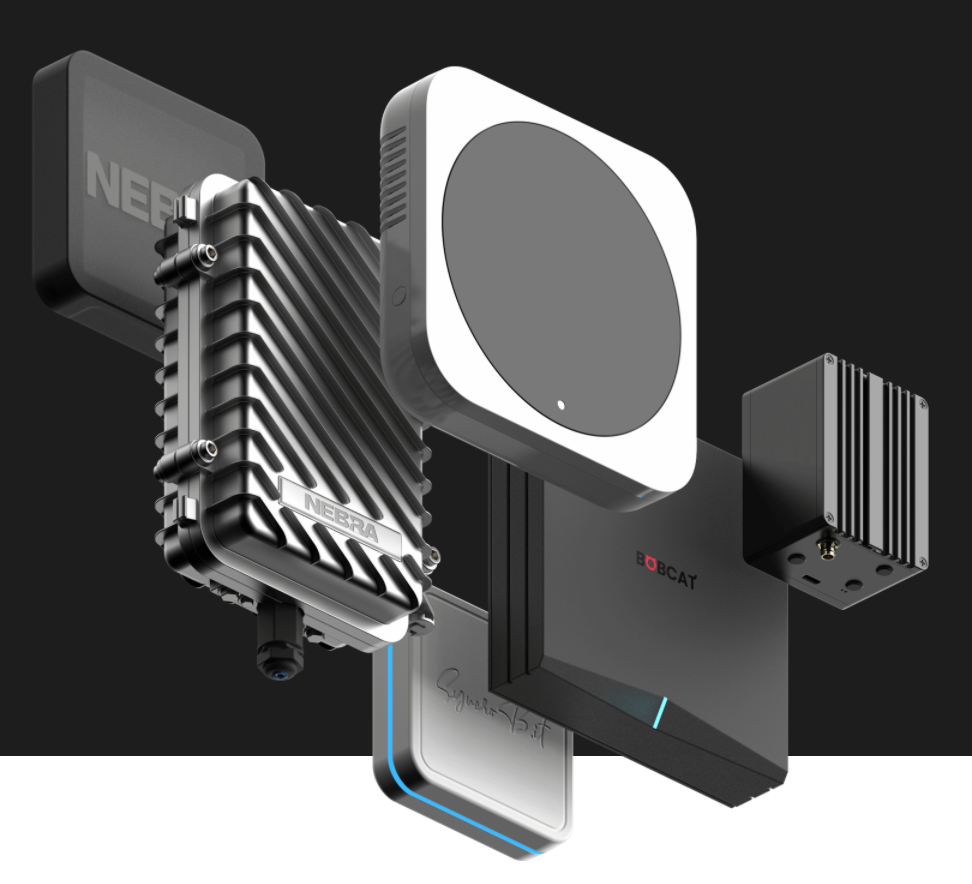
There are a couple of ways to obtain a hotspot, first is to buy one outright and the other is to host a hotspot in a profit share scheme.
Firstly buying the hotspot outright… there are a number of vendors who are officially endorsed to build and sell hotspots and they retail from around the £300 / $400 mark. With hotspots you own you earn 100% of the rewards for the hotspot providing it is place appropriately. You can view the vendors and hotspots which are officially endorsed here – https://www.helium.com/mine. The downside to buying a hotspot right now is the queue with most vendors is quite long due to supply and demand issues, if you order today (mid April 2021) you aren’t likely to see your hotspot until at least the summer.
The second option is to host a hotspot in a profit share scheme, in this instance a company such as Emrit ship you a hotspot that they own, sometimes for free and you earn a share of the HNT the hotspot mines, in Emrit’s case 20%. This is a good option if you want to mine HNT without the risk / capital outlay of buying hotspots. Profit share hotspot host schemes often ship sooner as they usually have hotspots in stock, different providers have different terms attached and you do not own the equipment.
In my case I have ordered my own hotspot and also ordered an Emrit hotspot as a stop gap until mine arrives, Emrit provides hotspots on on a 30 day rolling term so you can ship back the hotspot and return it at anytime.
Which hotspot is the best to buy?
Which hotspot to buy is largely up to you, they are all very similar as the core technology is the same. Some have different features e.g. outdoor enclosure / power of ethernet / antenna etc… The main differentiator right now appears to be delivery time scales between vendors. Before buying a hotspot you should ensure you are aware of the benefits and pitfalls of hosting a hotspot and also research each vendor and decide which hotspot is most suitable for you.
What region am I in?
Different regions need hotspots and devices configured for different frequencies, you can easily work out which region you are in, and hence which devices to buy by using – What Helium Region.
Why can’t I make a hotspot?
You may have heard people are building DIY Packet Forwarders or hotspots and think it’s a good route into hosting a hotspot, however you should be aware that these DIY HOTSPOTS ARE NOT ABLE TO MINE HNT! They provide additional coverage for the network but are currently not eligible for rewards, only hotspots manufactured by the officially supported vendors can mine HNT.
Why is a Raspberry Pi in a dress so expensive?
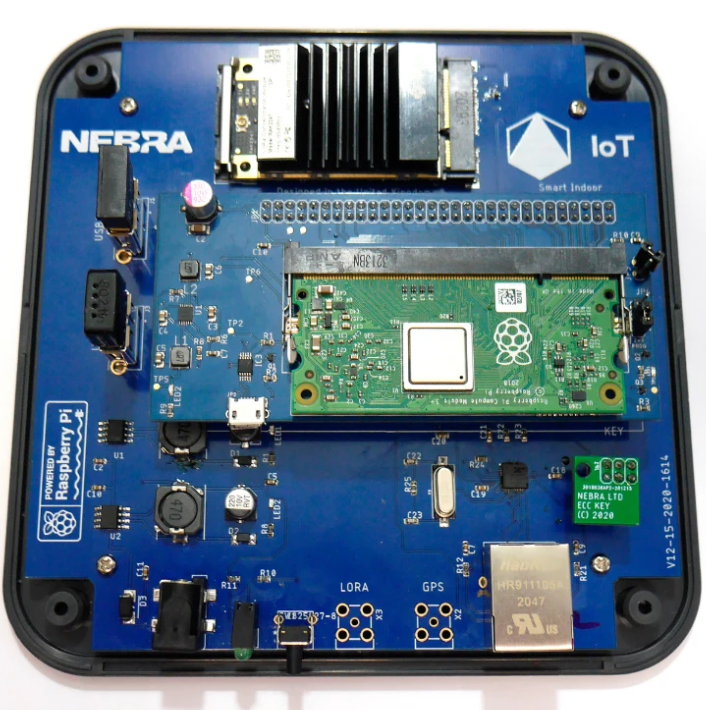
After reviewing the vendor’s photos of hotspots you may have noticed that many of them internally are Raspberry Pi based and started wondering, hang on, aren’t they just selling a £25 / $30 single board computer for 15x the price? However it is important to realise a Helium hotspot is quite of a different beast compared to an off the shelf Raspberry Pi. First off it contains a daughter board called a LoRa concentrator, in the photo above its the black board at the top of the image with the black heat sink. These themselves cost in the region of £100 / $120. Furthermore each hotspot has it’s own unique security chip issued by Helium which securely stores it’s keys, then there is the research and development time to build the custom back plane (blue PCB in the photo above) and the software running on the Raspberry Pi, and the case, and the included antenna and power supply, and then CE / FCC certification! As you can imagine the price to develop and produce the hotspot is quickly adding up for the vendor and suddenly the price seems reasonable / justified.
Why is it taking so long to get my hotspot?
Due to the recent price increase in HNT, coverage of Helium by crypto celebrities such as on YouTube and unprecedented sudden demand for hotspots the queue for hotspots from vendors has become fairly long. Unfortunately there isn’t much that can be done other than wait for vendors to scale and catch up.
Can’t I buy one off of eBay / insert sketchy guy here and skip the queue?
Technically yes, but it’s a really really bad idea, you are likely to pay WAAAY over the odds for a hotspot doing it this way, plus some of the eBay listings are burying / hiding the fact in the small print that they are in-fact offering a “pre-order” for delivery later in the year rather than actually having the hotspot to hand. Also pre-owned hotspots is a really bad idea, when you get a hotspot it has to be asserted to your wallet via the app. Once it has been asserted to you it’s linked to you and all earnings end up in your wallet. If someone has already asserted the hotspot you’ll essentially pay a lot of money to mine crypto for somebody else. The only recommended way to obtain a hotspot is from one of the officially recognised vendors listed here – https://www.helium.com/mine.
Where should I place my hotspot?
For the best coverage your hotspot should be placed as high as possible within your property and without any attenuators near by (metal, brick, lead, etc…) or ideally outside on the roof in a suitably rated enclosure (IP67). If this is not possible inside a window (without any metal film covering) on as high a floor as possible is best. Obviously the better the coverage the more likely you are to witness and be witnessed by other hotspots.
If you are placing your hotspot in a high location remember to follow health and safety best practice when working at height.
You should also be aware of density, hotspots that overlap in coverage share the rewards for covering that area, for this reason hotspots should be positioned at least 350m away from each other. There is a handy tool that can be used to help ensure your hotspots are appropriately spaced – https://helium.place/.
If you are not within reach of another hotspot your HNT rewards will be dramatically reduced compared to being able to witness and be witnessed by other hotspots, you should carefully consider placement prior to asserting your hotspot’s location. Remember the best positioning may not be at your house, but at a friend or family members house if they are happy to have your hotspot plugged in there.
You can test if you can reach another hotspot prior to asserting your hotspot by using a LoRaWAN device / mapper (Mapping Docs) to see if you can reach and pass packets via the other hotspot.
What internet connectivity does a hotspot need?
Hotspots should be hosted on a decent internet connection without usage caps, as part of the mining process they need to sync the block chain which can mean in the region of 50GB of data transfer per month. They also need to be able to keep up with the block chain, if they fall behind they may receive less or no rewards for coverage. This doesn’t mean it has to be fixed line internet, an 4G LTE / 5G modem could be used providing it’s data plan has sufficient bandwidth to deal with the block chain. For most an ethernet cable or WiFi connection to their residential / business internet connection should suffice.
How much power does a hotspot consume?
Unlike other crypto miners mining HNT is really green and power efficient, because it works on proof of coverage (the area covered by the radio network) rather than proof of work (how hard your CPU / GPU can do complex maths) the power usage is much lower, on some hotspots as low as 5 to 10W. If you live in a sunny place you may even get away with running it off of a suitably specced solar panel and battery.
What is a lone wolf & how can I fix lone wolf syndrome?
A lone wolf is a hotspot with no other hotspots near by to witness it and hence resulting in reduced reward earnings. There are a number of ways to fix having a lone wolf…
- Educate someone locally (over 350m away but still within range of your hotspot) about the benefits of hosting a Helium hotspot and see if they’d like to order one and run a hotspot.
- Buy another hotspot and host it at a friend of family member’s house (over 350m away but still within range of your hotspot).
- Borrow a hotspot from a profit share scheme and host it at a friend or family member’s house and use it to witness your hotspot.
- Wait until somebody else in the local area gets interested in Helium without intervention.
- If you have a very large property you may be able to place a second hotspot >350m on your own land.
Once you have another hotspot close by you should see witnessing occur and your HNT rewards increase.
How much am I going to earn?
It’s really hard to determine how much HNT you are going to earn, and even harder to determine a monetary value, you never know if it all goes pear shaped you might not earn anything at all!
Currently around 5 million HNT are mined every month, and this is shared amongst all of the hotspots, some receive more of a share than others based on their activities. Every 2 years the amount mined per month halves (next due in August) and hence mining becomes more difficult. Hence the figures I talk about now when there are only circa 25,000 hotspots and 5 million HNT mined a month are likely to change as hotspots flood the network and mining difficulty increases.
Luckily there is https://explorer.helium.com/ which can give us some clues to how much we may earn. First lets look at a lone wolf in my city and it’s earnings…
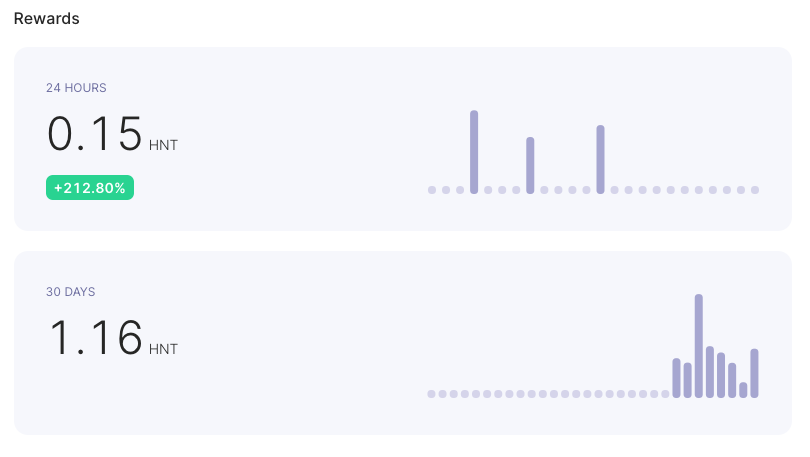
As you can see it is earning around 0.15 HNT a day or around $2.25 (at current price of ~$15). If we compare this to a well placed hotspots with many witnesses we can see the earnings are much healthier…
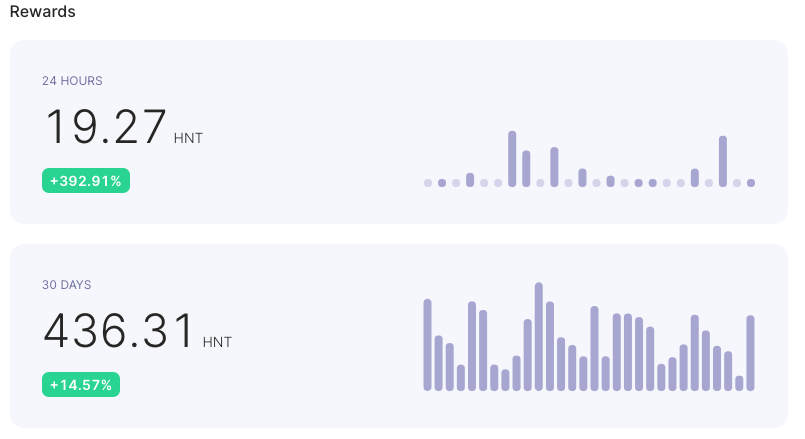
About 14 HNT a day or ~$210 at current price. Then we see cases where a hotspot only has 1 or 2 witnesses…
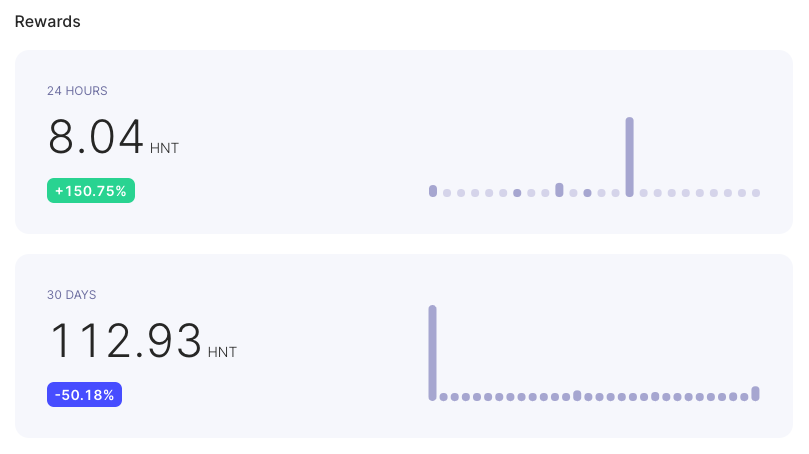
Ignore the big spike thats when the hotspot was chosen for a consensus group, in reality this hotspot with 2 witnesses earnt about 1.5 HNT a day aka ~$22.50 at current price.
This isn’t to say you’ll earn the same, but it gives an indication of what you may be able to expect, of course this could change vastly with time. As you can see HNT earnings depend greatly on positioning, witnesses, and luck. Actual monetary earnings are highly dependent on the volatile crypto market and the price of HNT fluctuates quite heavily, although has seen a sharp increase in the last couple of months as a result of more interest in the tokens.
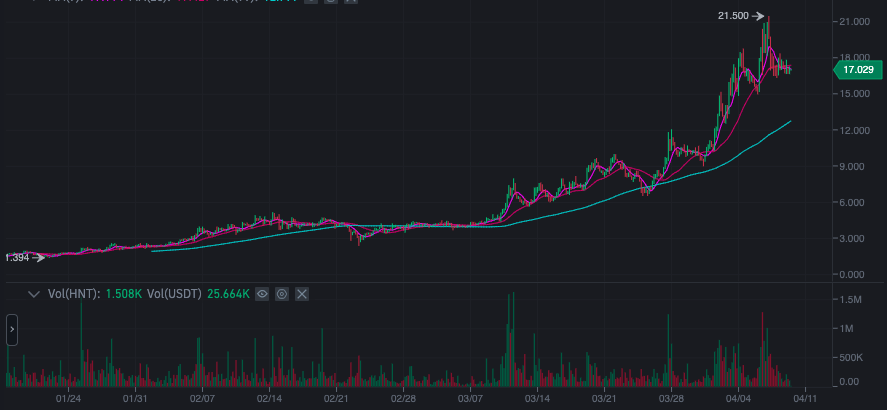
Who knows maybe next week it might be more, or maybe it could crash and be worthless? You should consider how much risk you are willing to take and research carefully and make sure you understand the potential earnings or losses when mining and trading crypto currency.
What happens when the difficulty increases?
It is hard to say what will happen when difficulty increases, what we can say is that as there will be many more hotspots and half the HNT rewards, therefore hotspots will earn less HNT when mining. Will it be worth less though? Who knows, that depends on the crypto market. All we can do is wait until it happens and see how the market reacts, maybe we win, maybe we lose, who knows? Hopefully with difficulty increasing and market confidence the price of HNT will increase to compensate the higher difficulty and hence the mining reward will be similar, although this is not guaranteed or may not even be likely.
Where can I find out more about mining?
A good place to learn more about mining is on the official Helium website – https://www.helium.com/mine.
Where can I sell my HNT for real money?
Many people ask where they can trade or exchange HNT as their usual crypto exchange doesn’t have the coin yet. So far I have been using Binance without issue – Binance.
Enjoy the FAQ? Want to support me?
If you enjoyed the FAQ and want to throw a bit of crypto at me you can tip with the following coins:
- HNT – 14SSedssDPfL7hNFzRdyizA4cFLPUyQ5xQ2Ti6iqKBwxFbvbad1
- ETH – 0xe5455bdb2d9b170c95b5742cbedf10cc0f2cb2ef
- BTC – 12TSoJ4ZbgHG6gaezpGXZ65AFAndg2QeaE
- BAT – Tip via Brave Browser tipping feature
Disclaimer (again!)
Fiddling with crypto is generally a risky venture and your cashola is at risk. This is not financial advice and any crypto dabbling you do is entirely at your own risk. Prices and earnings correct at time of publishing but will vary with time.
7 Comments
Great work
Thanks 🙂
Thanks, this post is very useful.
I was trying to figure out what Helium should be worth based on the fixed cost of data credits and the number of packets handled. However the relationship between packets handled and the awarded Helium is … complex. Not only that but I can’t figure out how many packets my hotspots are handling which would allow me to make a backwards inference from the helium awarded.
Is there a way to see how many packets my hotspot is handling? Any light shed on this much appreciated. I do realize that this will change over time.
Hello Richard,
You may check how many packets your hotspot has handled at https://explorer.helium.com. However the statistics here are very basic. I heard about a project “Kudzu” which provides a dashboard with more in depth hotspot planning and analytics. Currently I think it pulls data from the Helium API although it looks like they are also making an alternate packet forwarder that has the ability to report stats directly from the hotspot.
Best Regards,
Rob
Thanks Robb. I find individual packet transfer transactions for some hotspots but when clicking on those get sent to a “state channel close transaction” which lists packet transaction data from 2000 hotspots but I see no way to tie that back to hnt earned either in the aggregate or otherwise. The amusing thing is that my hotspot is earning decent amounts of hnt while apparently having 0 packet transactions (which would seem to be the whole point of a “people’s network”). I’m a complete novice at this but not finding much transparency despite a lot of “data”.
Thanks for the post. My question deals with health and fueling of a miner. Can you explain these terms in relation to mining helium? Tia